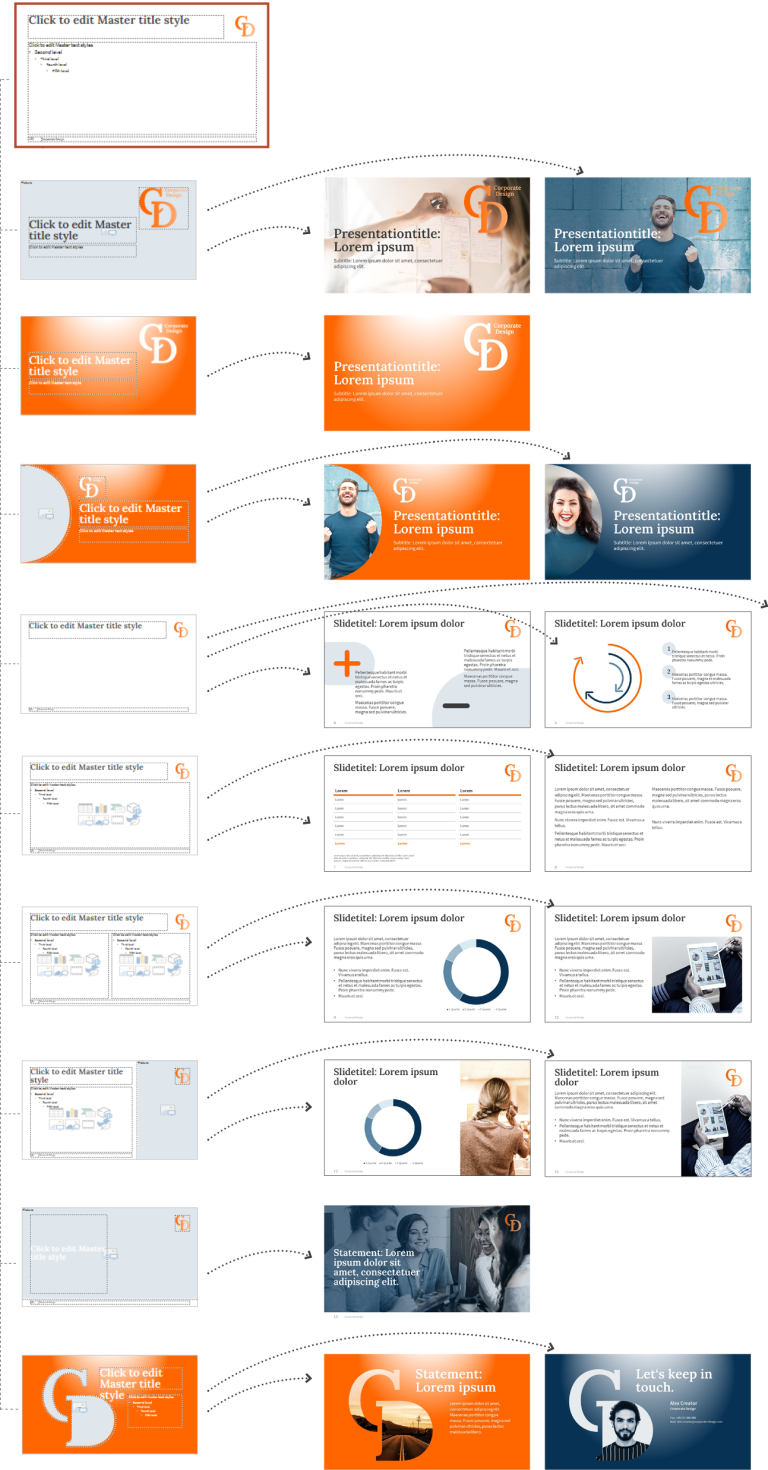Professional PowerPoint usage:
Master your masters, layouts and slides
PowerPoint presentations are the standard for business communications, both internal and external. But PowerPoint is often used sloppily, even in the world’s leading companies. Tens of thousands of employees don’t use the software properly, creating loads of additional work, which costs time – and money. Besides this, many presentations aren’t even slightly aligned with the company’s corporate design guidelines, either.
But here’s the thing: using PowerPoint correctly within your company is not that difficult at all. Here we explain how to structure a professional PowerPoint master, and what to look out for when using it.
The slide master
This forms the basis of every PowerPoint slide, and lays down the basic elements of corporate design, for instance
- the slide layout – margins, position of headline, subhead, body text and footer
- design elements, such as logos or colored bars and lines
- the company colors and fonts
- text style – text levels, font sizes, bullet point styles, line and paragraph spacing
Layouts
Whereas the basic elements of a corporate design are created in the slide master, layouts show the places on the slide where text, charts or tables are to be inserted, with the help of placeholders.
In PowerPoint, go to the “View” menu and select the “Slide Master” view. The slide master is shown at the top. Underneath you’ll see the various layouts, for instance, for title slides, section slides or slides with whole-page content (for text, charts, tables, etc.). These layouts should include all the standard slide types in the company.
In the “Start” menu, click the lower half of the “New Slide” button to choose from the available layouts. Selecting one of these opens a new slide based on that particular layout, where you can then insert your content.
Templates and presentations
PowerPoint masters and layouts are saved to a file with the extension .potx. The current version of the PowerPoint template should be made available to all employees. If you double click on this .potx file in File Explorer, a new presentation is opened (with the file extension .pptx), which you can start working with straight away. The template itself remains unchanged.

Practical tips for marketing and communications professionals
When a new or changed corporate design is implemented, sooner or later your PowerPoint master will have to be revised. While branding agencies generally know a great deal about corporate design, they usually lack expertise in PowerPoint.
This is where specialists like Strategy Compass can help. We create your PowerPoint master, while implementing your design concept within PowerPoint. It doesn’t cost much and saves thousands of users a lot of effort.
Most employees who use PowerPoint don’t have much experience in design. They haven’t the time to learn detailed style guides and often find them difficult to implement. When creating a PowerPoint master, find a workable compromise between adhering to the corporate design and its practical application. If the design specifications are difficult to implement within PowerPoint, they’ll simply be ignored. It makes sense to make the PowerPoint master as user friendly as possible, and to provide key slides and ready-to-use elements (e.g. charts, icons and images) already featuring the corporate design.
Practical tips for PowerPoint users
Using PowerPoint correctly makes producing your own presentations much easier. It also pays off when slides from several colleagues are compiled into one presentation. If everyone uses PowerPoint correctly, many of the typical revisions can be avoided.
- Always use the current master. Preferably the .potx file that you use to create a new presentation. This prevents mistakes being duplicated.
- Use the correct layouts. With layouts, you don’t have to think about where your content should be positioned on the slide. Furthermore, the placeholders already contain the correct formatting – especially for text. If a placeholder gets moved, you can easily get it back to its correct position using the “Reset” function in the “Start” menu.
- When you insert text into the placeholder, it will be formatted automatically in line with the corporate design. Each text level has a prescribed format. You can change the text level using the functions “Increase List Level” and “Decrease List Level” in the “Start” menu. Note: Don’t use the “Bullets” function, as this ignores the predefined text formatting that’s laid down in the master.
- Often slides from old presentations are needed as part of a new presentation. You or your colleagues might have created those slides using an old template. If you want to use slides from presentations which are so outdated, it’s usually best to redo them. Otherwise, you risk errors cropping up in your presentation without you even noticing. Create a new slide based on the relevant layout and copy and paste the individual elements from the old slide into the new slide (don’t copy the entire slide). You can paste charts or images into the relevant placeholders to position them correctly. Text is best pasted into the relevant placeholder using the option “Keep Text Only,” with the correct text level selected as described above.
If you need help with creating a new PowerPoint master, or want to check an existing master, just get in touch with us. We’re professionals and experts, both in design and technical know-how, and can advise you on how to get the most out of PowerPoint to increase efficiency in your company.